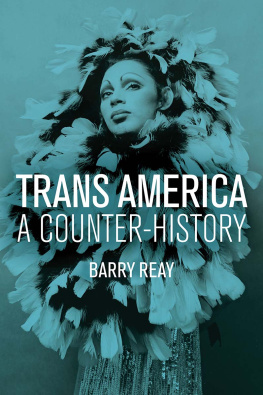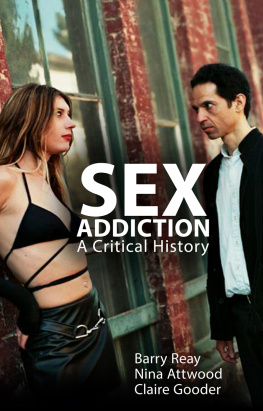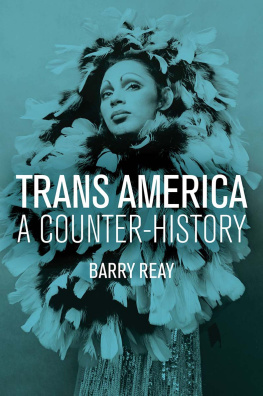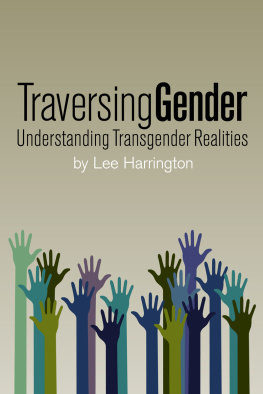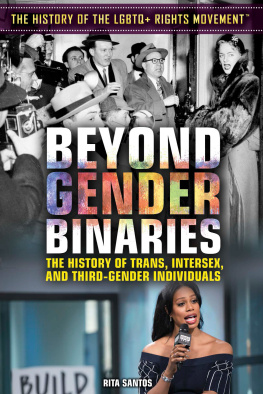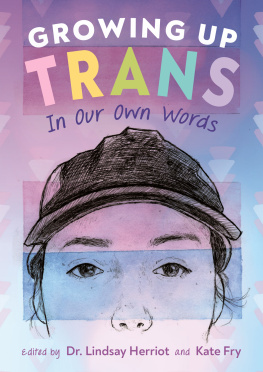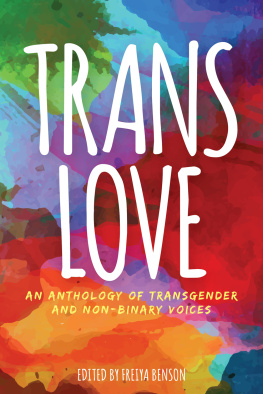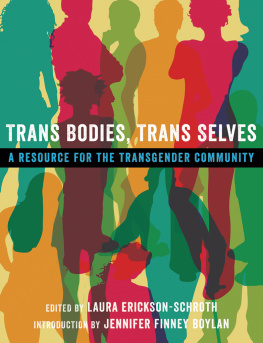
Trans America places the recent conversation about trans issues in its historical context, in impressive depth. Sweeping across the twentieth and twenty-first centuries, Barry Reay provides an accessible yet comprehensive guide to the important people, places, and trends, in the US and beyond ideal for anyone who wants to understand what came before the Transgender Tipping Point.
Juliet Jacques, author ofTrans: A Memoir
The richly varied nature of the current trans movement is so beautifully explored and uncovered in Barry Reays new book. A pleasure to read.
Fayette Hauser of The Cockettes
This is an admirable contribution to trans history by a highly respected scholar. It is a story of shifting categorizations, often highly medicalized and limiting, but above all a narrative of agency as trans people pushed definitions to the limit, bent them, and broke them, and increasingly spoke for themselves in a powerful, if not always singular, voice. Its a major achievement and deserves to become a classic.
Jeffrey Weeks, London South Bank University
This book is of very high quality. Reay is a major scholar in the field and writes with great authority and assurance.
Thomas Laqueur, University of California at Berkeley
Trans America
A Counter-History
Barry Reay
polity
Copyright Barry Reay 2020
The right of Barry Reay to be identified as Author of this Work has been asserted in accordance with the UK Copyright, Designs and Patents Act 1988.
First published in 2020 by Polity Press
Polity Press
65 Bridge Street
Cambridge CB2 1UR, UK
Polity Press
101 Station Landing
Suite 300
Medford, MA 02155, USA
All rights reserved. Except for the quotation of short passages for the purpose of criticism and review, no part of this publication may be reproduced, stored in a retrieval system or transmitted, in any form or by any means, electronic, mechanical, photocopying, recording, or, otherwise, without the prior permission of the publisher.
ISBN-13: 978-1-5095-1182-2
A catalogue record for this book is available from the British Library.
Library of Congress Cataloging-in-Publication Data
Names: Reay, Barry, author.
Title: Trans America : a counter-history / Barry Reay.
Description: Cambridge ; Medford, MA : Polity, 2020. | Includes bibliographical references and index. | Summary: A history of trans before the trans moment-- Provided by publisher.
Identifiers: LCCN 2019043752 (print) | LCCN 2019043753 (ebook) | ISBN 9781509511785 | ISBN 9781509511792 (pb) | ISBN 9781509511822 (epub)
Subjects: LCSH: Transgender people--United States--History. | Gender identity--United States--History.
Classification: LCC HQ77.95.U6 R43 2020 (print) | LCC HQ77.95.U6 (ebook) | DDC 305.3--dc23
LC record available at https://lccn.loc.gov/2019043752
LC ebook record available at https://lccn.loc.gov/2019043753
The publisher has used its best endeavours to ensure that the URLs for external websites referred to in this book are correct and active at the time of going to press. However, the publisher has no responsibility for the websites and can make no guarantee that a site will remain live or that the content is or will remain appropriate.
Every effort has been made to trace all copyright holders, but if any have been overlooked the publisher will be pleased to include any necessary credits in any subsequent reprint or edition.
For further information on Polity, visit our website: politybooks.com
Introduction
Trans seems to be everywhere in American culture. Yet there is little understanding of how this came about. Are people aware that there were earlier times of gender flexibility and contestability in American history? How well known is it, say, that a previous period of trans visibility in the 1960s and early 1970s faced a vehement backlash right at the time that trans, in the form of what was then termed transvestism and transsexuality, seemed to be so ascendant? Was there transness before transsexuality was named in the 1950s and transgender emerged in the 1990s?
This book explores this history: from a time before trans in the nineteenth century to the transsexual moment of the 1960s and 1970s, the transgender turn of the 1990s, and the so-called tipping point of current culture. It is a rich and varied history, where same-sex desires and identities, cross-dressing, and transsexual and transgender identities jostled for recognition. It is a history that is not at all flattering to US psychiatric and surgical practices.
There are competing narratives in trans history. Some have maintained that convictions of gender dislocation have always existed; this was claimed in True Selves (1996), the popular guide to transsexuality recommended by Jennifer Finney Boylan when she declared her transition to her academic colleagues: one indisputable fact remains: transsexualism exists and has always existed.
For others, far from always existing, transsexuality was a late-twentieth-century phenomenon. As Catherine Millot once put it, there is a sense in which there was no transsexuality before experts like Harry Benjamin and Robert Stoller invented it.
One of the notable aspects of trans history is the rapid shift in sexual and gender configurations.
The category transgender includes people who want to create and/ or retain characteristics of both genders and who see themselves as neither or both male and female; significantly, other pieces by Bolin in the 1990s argued for far more gender flexibility.
We are now past the moment when the inaugural 2014 issue of the new academic journal TSQ: Transgender Studies Quarterly, itself indicative of the shift, could refer to the postposttranssexual.
Today trans is everywhere, wrote Jacqueline Rose in 2016.
There is a comprehensive, trans, self-help guide, Trans Bodies, Trans Selves (New York, 2014), the trans equivalent to the iconic feminist text Our Bodies Ourselves.
There are foundational Transgender Studies Readers, representing both Transgender Studies 1.0 and Transgender Studies 2.0..

A transmasculine doctor in front of his computer.
Hence, it has become possible to ask, Is Pop Culture having a Trans Moment?
I will be using the literature of psychology, psychiatry, and modern surgery among my source material. But that does not mean that I have been captured by what is usually called the medical model, where trans is viewed through the lenses of the medical and psychiatric experts, the gatekeepers of transition. Some trans advocates, as we will see, are deeply suspicious of such influences; others have opted to work strategically within the system.
Obviously, the medical model has framed discussion and shaped the lives first of transsexuals and then of transgender people; it has determined the rules, the parameters, the gates to treatment, and even self-perception. Austin Johnsons labels hegemonic and normative are entirely appropriate.
Yet, despite this dominating role, there has still been room for trans agency, evidence of what Dean Spade has termed a self-conscious strategy of deployment of the transsexual narrative by people who do not believe in the gender fictions produced by such a narrative, and who seek to occupy ambiguous gender positions in resistance to norms of gender rigidity. She carefully avoided complicating the expected narrative.
Next page
